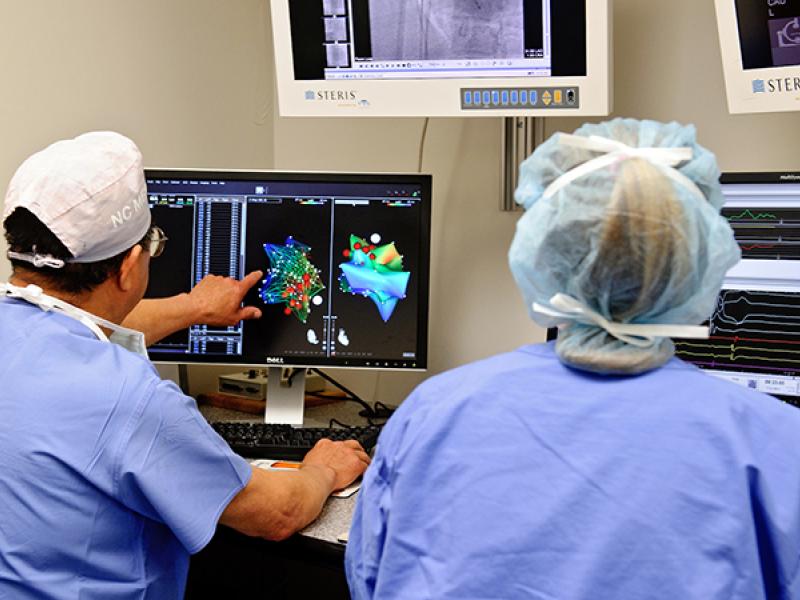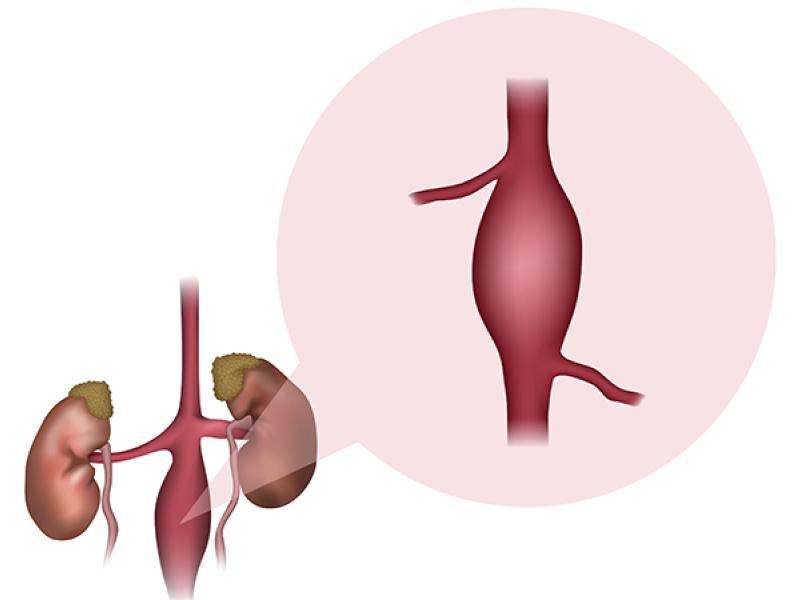The goal of the Electrophysiology and Arrhythmia service is to provide special instruction in the diagnosis and treatment of patients with cardiac arrhythmias. An emphasis will be on understanding the pathophysiologic mechanisms of disease, the usefulness of specialized diagnostic and therapeutic procedures, and an appreciation of the long-term challenges faced in follow-up of patients with cardiac arrhythmias.
Additionally, fellows will acquire understanding of management options of cardiac arrhythmias, including pharmacology, implantable electrical devices, and ablation. Fellows will rotate as a part of the cardiac arrhythmia team and participate in evaluation/consultation of patients, ECG/telemetry interpretation, interrogation of pacemakers and implantable cardioverter-defibrillators, formulation of management plan, and participate in electrophysiologic procedures. The fellow will interact professionally with patients, family members, and all members of the healthcare team, as well as engage in shared decision-making with patients.
Rotation leader
Dr. Sandeep Gautam
Objectives
1st year fellow (one rotation)
- Obtain appropriate history and physical, review relevant ECG/telemetry findings, and formulate assessment and plan for inpatient consults.
- Identify characteristics of normal sinus rhythm and understand mechanism of sinus node dysfunction.
- Explain pathophysiology and ECG findings of atrial fibrillation and atrial flutter.
- Understand the fundamentals of managing atrial fibrillation and atrial flutter, including rate versus rhythm control and indications/contraindications of anticoagulation to reduce the risk of stroke.
- Identify types and mechanisms of atrioventricular block and determine appropriate work up and management.
- Begin to describe indications, contraindications, and associated complications of permanent pacemaker placement, implantable cardioverter-defibrillator placement, and cardiac resynchronization therapy.
- Identify differential diagnosis, ECG characteristics, evaluation, and management for supraventricular tachycardias.
- Begin performing basic device interrogation, including identification of arrhythmia events and understanding of programming modes.
- Understand differential diagnosis, evaluation, and management of syncope.
- Develop approach for diagnosis of wide complex tachycardia.
- Perform synchronized direct current cardioversion under supervision.
- Perform defibrillation of unstable ventricular arrhythmias.
- Know the basics of radiation safety.
2nd year fellow (one rotation)
In addition to the above:
- Describe mechanisms of action of antiarrhythmic medications and understand indications/contraindications as well as parameters for monitoring.
- Understand pathophysiology, mechanism of action, evaluation, and management of non-sustained and sustained ventricular tachycardia.
- Describe the differential diagnosis and management of re-entrant and atrial tachycardias.
- Understand the significance of inherited diseases (including congenital heart disease, ion channel abnormalities, and structural heart conditions) in the evaluation and management of cardiac arrhythmias.
- Describe the risk stratification and management of sudden cardiac death, including in athletes.
- Detail indications and risk for non-invasive testing in evaluation of arrhythmias, including ambulatory monitoring, implantable loop recorder, and tilt table testing.
- Understand indications, limitations, and associated complications of non-invasive testing, as well as invasive electrophysiological testing and catheter ablation.
- Identify ventricular pre-excitation and understand diagnostic evaluation and management.
- Independently perform complete device interrogation and basic programming changes.
- Know all indications, contraindications, and associated complications of permanent pacemaker placement, implantable cardioverter-defibrillator placement, and cardiac resynchronization therapy.
- Place temporary pacemaker under supervision (may also occur in cardiac catheterization laboratory or cardiac intensive care unit).
- Complete COCATS level 1 training which includes at least 2 months rotating on the electrophysiology service as well as a minimum of 20 cardioversions and placement of 5 temporary pacemakers.
3rd year fellow (Elective additional one to four rotations to achieve level 2 training)
In addition to the above:
- Execute device interrogation, advanced programming changes, and troubleshooting of permanent pacemakers (single chamber, dual chamber, and biventricular) and implantable cardioverter-defibrillators.
- Perform remote device interrogation.
- Perform under supervision permanent pacemaker implantation of both single-chamber and dual-chamber devices as well as manage associated complications.
- Perform under supervision implantable loop recorder insertion, as well as interpretation and integration of results into patient management.
- Perform tilt table testing.
- Complete COCATS level 2 training with a total of six months.
- Without pacemaker implantation: Complete at least 100 device interrogations/programming and at least 25 remote device interrogations
Fellow responsibilities
- One cardiovascular disease fellow is usually assigned to the EP rotation.
- Evaluate patients for whom an arrhythmia consultation has been requested at MUHC or VA and present cases to the designated EP attending for the week. When no general fellow assigned to EP, consultations are seen by the clinical cardiac electrophysiology fellow.
- In concert with the clinical cardiac electrophysiology fellow, place pre-procedure orders the day prior to outpatient procedures when needed.
- On procedures they are participating in, fellows are expected to evaluate patients on day of procedures including review of laboratory work up, perform history and physical examination, obtain consent, and document pre-procedure assessment.
- Post procedure, fellows are expected to place admission/discharge orders and sign out to the team on call that night regarding patients who are staying on observation/short stay.
- Each morning, assess and discharge patients who stay overnight.
- Attend weekly EP conference
- Attend at least one EP clinic with designated attending per week.
- Attend weekly device clinic at the VA on Thursday morning.
First year fellow responsibilities
- Understanding basics of EPS through didactics
- Follow-up of patients with permanent pacemaker/ICD’s
Second and third-year fellows
In addition to the above:
- Follow-up of patients with permanent pacemaker/ICD’s
- Basic electrophysiologic studies including vascular access, positioning of catheters, evaluation of Sinus node recovery time, programmed stimulation and mapping techniques
- Implantation and follow-up of permanent pacemakers
- Assisting in radiofrequency ablation procedures, as needed
- Assisting in implantation of ICDs, as needed
Attending responsibilities
- Meet with fellow daily, both before and after procedures, for debriefing of procedure, planning care and management of patients, and teaching.
- The designated EP attending for consultations for the week will round daily with fellow on consultation patients.
- Directly supervise procedures in the EP lab.
- Provide didactic teaching daily when EP consultation attending.





